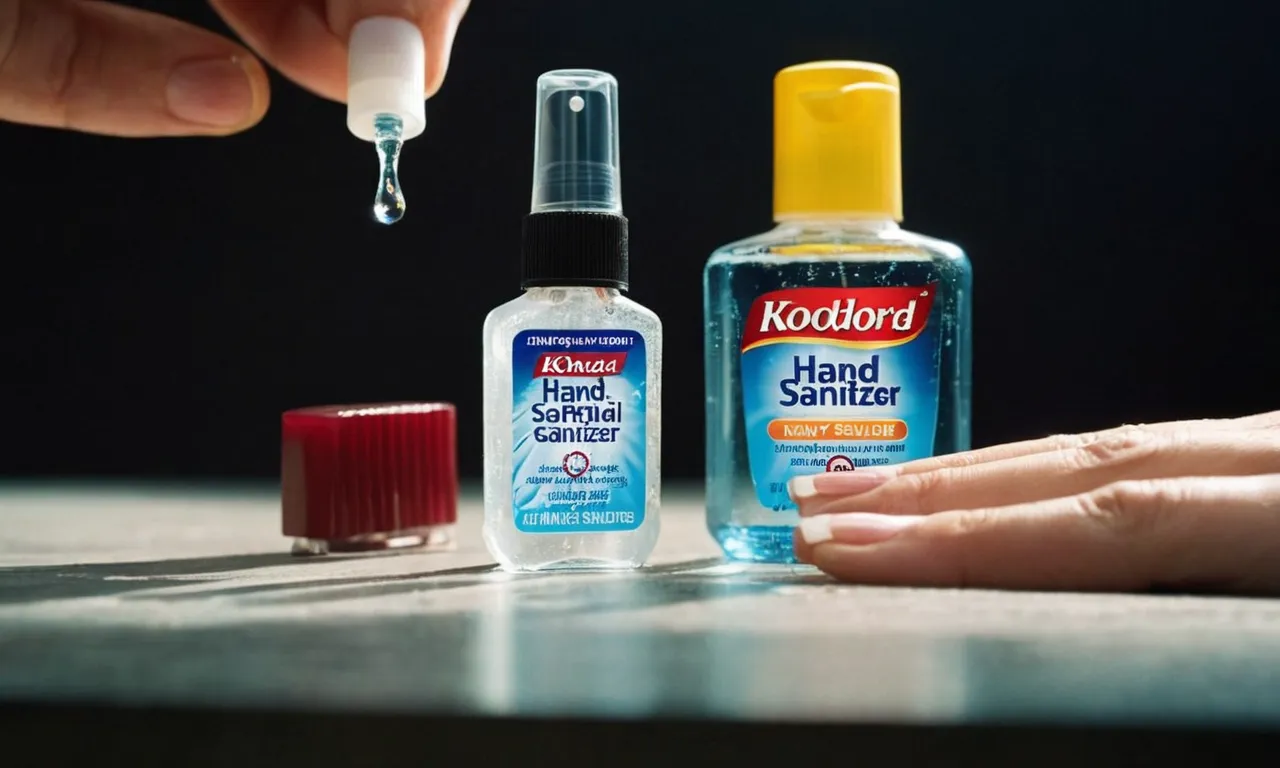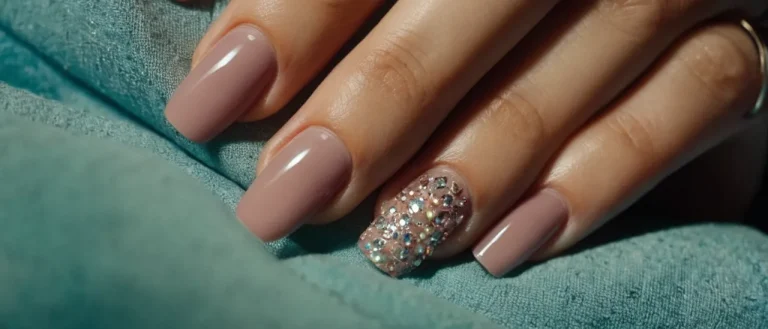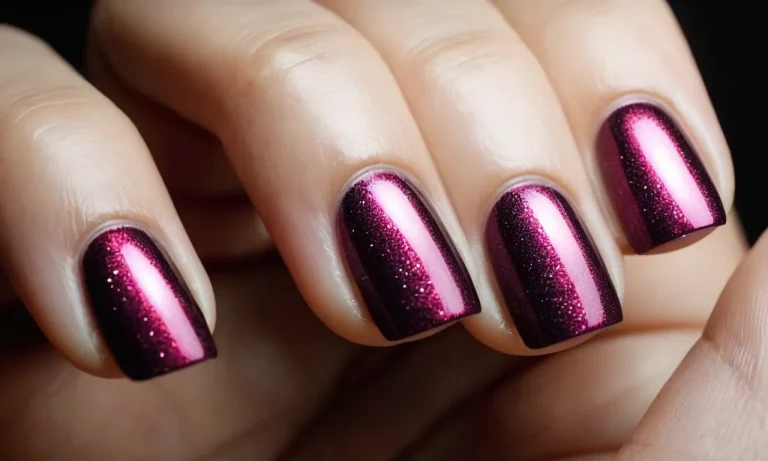Does Hand Sanitizer Kill Nail Fungus?
If you’ve noticed yellow, crumbly nails with white spots, you may have a fungal nail infection. Nail fungus is a common condition that begins as a white or yellow spot under the tip of your fingernail or toenail.
As the fungal infection goes deeper, nail fungus may cause your nail to discolor, thicken and crumble at the edge. If you have nail fungus, you may wonder if simply applying hand sanitizer to the affected nails will kill the fungus and cure the infection.
If you’re short on time, here’s a quick answer to your question: Using hand sanitizer alone will not cure a nail fungus infection. While the alcohol in hand sanitizer may temporarily reduce fungal growth, it does not penetrate deep enough into the nail to kill the fungus at its source.
What Is Nail Fungus?
Nail fungus, also called onychomycosis, is a common condition caused by a group of fungi known as dermatophytes that feed on keratin, the protein that makes up hair, skin and nails. These microscopic organisms can infect fingernails and toenails, causing thickening, discoloration, crumbling and distortion of the nail.
If left untreated, the infection can spread and eventually destroy the nail, causing pain, discomfort and embarrassment. According to the American Academy of Dermatology Association (AAD), about 10% of the general population suffers from toenail fungus.
Causes and Risk Factors
Dermatophytes thrive in warm, moist environments like public showers, locker rooms and pools, infecting nails through tiny separations or cracks in the nail bed and cuticle. People with certain medical conditions like diabetes, psoriasis and poor circulation are more prone to the infection.
Other risk factors include overexposure to water, family history, aging, nail trauma, walking barefoot in damp communal areas and having reduced immunity. Using acrylic nails or artificial nails also raises the risk due to extra moisture trapped under the false nail.
Signs and Symptoms
The most common signs are a white, yellow or brown-colored discoloration under the tip of the nail with associated thickening and crumbling. As it progresses, the infection causes the nail to detach from the nail bed. Early signs include the nail becoming dull, scored and ragged with raised streaks.
Other symptoms are foul-smelling nail debris, pain or discomfort, and oil spots under the nail. The nails may also emit a foul odor. Toenails tend to be affected more than fingernails as they endure more exposure to fungi-friendly environments.
Complications
While a simple fungal infection may cause concerns over appearance, if left untreated for long periods, severe health issues can occur especially for those with diabetes or impaired immunity. Cellulitis, a bacterial skin infection, can happen if the infection spreads into the skin and underlying tissues.
The spreading infection may also damage adjacent toes and lead to foot ulcers. In rare cases, a serious bone infection called osteomyelitis may develop, requiring hospitalization. People with continuing issues should see a podiatrist or dermatologist for professional treatment.
Does Hand Sanitizer Kill Nail Fungus?
Nail fungus, also known as onychomycosis, is a common nail infection that can cause nails to become discolored, thickened, and brittle. Many people wonder if using hand sanitizer can help treat or prevent nail fungus.
Here’s an overview of how hand sanitizer works and its effectiveness against nail infections.
How hand sanitizer works
Hand sanitizers are liquid solutions that typically contain alcohol, such as ethyl alcohol or isopropyl alcohol, as the main active ingredient. Many hand sanitizers contain 60% to 95% alcohol by volume.
When applied to the hands, the alcohol in hand sanitizers destroys many disease-causing microbes and viruses.
By breaking down the outer membranes and proteins of microbes, alcohol denatures and kills many types of germs, including fungi. This makes hand sanitizer an effective way to eliminate germs that can cause infections when introduced into openings in the skin.
Hand sanitizers also evaporate quickly, which further prevents growth of remaining microbes.
Limitations of hand sanitizer
While hand sanitizers kill many microbes on skin surfaces, they have significant limitations against nail fungus. Fungi that cause nail infections live under the nail bed, deeper than hand sanitizer can reach.
So while using hand sanitizer may kill some fungal spores on skin surrounding nails, it likely cannot penetrate down into the nail bed to access established infections.
In one small 2021 study, researchers tested an ethanol-based hand sanitizer gel on fungal spores and found it only inhibited growth by about 34%. They concluded hand sanitizer has minimal fungicidal effect compared to oral and topical nail fungus treatments.
Can help temporarily reduce growth
Using hand sanitizer around infected nails may provide some temporary benefits by killing fungal spores on nail edges and surrounding skin. This can slow transmission and reinfection. But its effectiveness only reaches the surface.
Dermatologists universally agree that hand sanitizers do not cure nail fungus. At best, they may temporarily suppress additional growth before more effective topical or oral antifungal treatments can work within the nail bed to eliminate infections.
| Hand Sanitizer | Prescription Treatments |
|---|---|
|
|
The takeaway is that while hand sanitizers can reduce germs on hands, they do not effectively treat stubborn nail fungus infections. Seeking professional treatment is the best way to cure nail fungus problems.
Effective Nail Fungus Treatments
Prescription antifungal medications
Prescription oral and topical antifungal medications prescribed by a doctor are considered one of the most effective ways to treat stubborn toenail fungus infections (American Academy of Dermatology).
Popular prescription antifungals include terbinafine (Lamisil), itraconazole (Sporanox), and fluconazole (Diflucan). These strong medications stop the growth of fungus and allow the infected part of the nail to grow out. A complete cure can take 3-12 months depending on the severity of infection.
Success rates are high with prescription meds, but they do come with more risk of side effects like nausea or liver problems in some cases.
Laser therapy
Laser treatments that utilize concentrated beams of light to precisely target and eliminate fungus are emerging as a revolutionary cure for toenail fungus. Clinical studies show laser therapy can completely destroy stubborn fungal infections in 78% of patients after just one or two sessions (NCBI).
The laser light damages fungal cell walls and mitochondria to stop growth and reproduction. Compared to slow-acting pills, laser therapy also clears infections much quicker – visible improvements can be seen in as little as 5 days!
The treatment is non-invasive and safe with virtually no side effects. 👍 The biggest downside to laser anti-fungal therapy is the high costs since most insurance does not yet cover it.
Nail removal
In severe cases where the nail fungus has extensively damaged the entire nail bed, permanent nail removal surgery may be an effective option. This treatment removes the infected nail so a healthy new one can regrow fungus-free.
Studies show nail removal has an 82-87% long term success rate for eliminating stubborn fungal infections that resisted other treatments (NCBI).
The nail removal procedure is relatively simple and can be performed under local anesthesia in an office visit. After numbing the toe, the doctor uses a special instrument to fully detach and extract the infected nail from the nail bed.
Over the next several weeks, the nail bed heals and allows a new nail to gradually emerge. 👏 Full regrowth takes 9-12 months. Since the new nail grows under fresh tissue, the chance of recurrence is very low. The main drawback is coping without a nail for almost a year!
Tips for Prevention
Practice good hygiene
Maintaining good hygiene is crucial to prevent nail fungus. Here are some tips:
- Wash your hands thoroughly with soap and water, especially after touching contaminated surfaces.
- Clean under nails gently every time you wash your hands.
- Dry your hands and feet thoroughly after washing by gently patting and making sure to dry between toes.
- Don’t share towels, socks, shoes or nail care tools with others to avoid cross-contamination.
Keep nails trim and dry
Keeping toenails trim and dry creates an unfavorable environment for nail fungus growth. Follow these recommendations:
- Trim nails straight across to prevent ingrown toenails.
- File down thickened parts of nails to prevent fungus getting underneath.
- Wear breathable socks and change them regularly if damp.
- Apply antifungal or drying powder to feet to absorb moisture.
Wear shower shoes in public areas
Wearing protective footwear in humid public places prevents exposure to fungal spores according to dermatologists. Consider these tips:
- Wear flip flops, water shoes or shower shoes when using public pools, showers and locker rooms.
- Use disposable pedicure slippers if getting a professional pedicure.
- Bring your own nail file and tools if you regularly get manicures/pedicures.
Avoid sharing nail tools
Sharing instruments that haven’t been properly sanitized can transfer fungus from person to person. Here is advice to follow:
- Have your own personal nail clippers, files and other instruments.
- Clean tools with hydrogen peroxide or isopropyl alcohol between uses.
- Don’t try tools or polish testers at beauty supply shops.
- Ask nail salons about their sanitization practices.
Implementing good nail hygiene and using caution with pedicure equipment are effective ways to help prevent frustrating nail fungus. With some simple precautions, you can keep nails looking healthy.
Conclusion
While using hand sanitizer may seem like an easy home remedy for nail fungus, it does not cure the infection when used alone. To treat nail fungus effectively, prescription oral medications or laser therapy are required to kill the fungus at its roots under the nail bed.
Using hand sanitizer can temporarily reduce fungal growth and prevent spread while you undergo medical treatment. But ultimately, a combination approach of prescription antifungals, debridement and preventive hygiene routines will provide the best chance of eliminating stubborn nail fungus infections.







